Samsung Fascinate Review: Verizon's Galaxy S Smartphone
by Brian Klug on October 5, 2010 12:01 AM EST- Posted in
- Smartphones
- Samsung
- Galaxy S
- Fascinate
- Mobile
Super AMOLED
Anand talked about the Galaxy S line's Super AMOLED display in his Epic 4G review. I thought I'd expand on that by saying that reducing the number of layers and air gaps between display, coating, capacitive digitizer, and finally top layer glass, is what the "Super" in Super AMOLED is all about.
It might not sound like a big deal, but reducing the number of interfaces between those light emitting OLED pixels and your eye is hugely important. Each successive interface - purely by being an interface with different index of refraction - creates a reflection that attenuates light. Glass to air interfaces usually have a reflection coefficient of around 4%, meaning only 96% of light makes it through. If you've got two or more air-glass interfaces, that adds up quickly, and you lose that light entirely to reflection. How much that reflection coefficient is depends on the index of materials at the interface, but more interfaces in general hurts transmission. Reflections and glare is also what makes reading displays difficult outside.
This sort of display-digitizer lamination is quickly becoming the norm rather than the exception. The iPhone 4 did it, and now Samsung is doing it with its own AMOLED displays - expect to see others do the same. The result is that there's perceptibly less distance between the top of the digitizer and the pixels themselves (viewed from an angle), and now less glare and more light making it through. Yay for optical contact!
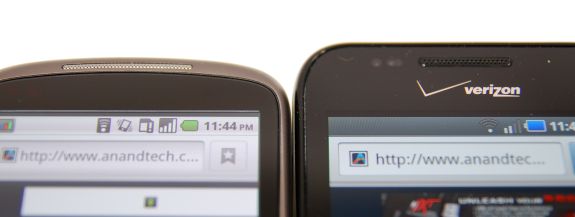
View this one bigger in full size to see what I mean
Next to the Nexus One, you can really see how much less distance there is between pixels and the surface of the top glass. The Samsung's Super AMOLED display literally appears to be on the surface.
The front of the Fascinate is one unbroken glass surface. Honestly, the display is probably the best part of the Fascinate. The 4" size isn't too big, but just right. At the bottom are capacitive buttons - as usual in yet a different order than I'm used to. Menu at the far left, home, back, then search from left to right.
The buttons are backlit, but only for a few seconds at a time. It's a bit frustrating, especially since right when you want them to be backlit most, they're inexplicably not lit.
I'd say AMOLED has come a long way since the Nexus One. My Nexus One routinely has ghosting and appears off-white - the Fascinate's Super AMOLED display is perfect. I used to be turned off by AMOLED's weird grain from the PenTile matrix - the Fascinate somehow has noticeably less. Either that, or I've just grown more accustomed to it. The oversaturation downside is still there, it's especially obvious when you pull screenshots from the Fascinate or any AMOLED device down to the desktop on a calibrated display.
Outside readability in practice is improved from the Nexus One. Honestly, it's still hard to read in direct sunlight outside, but it's better. For doing just about anything, seek shade.
Viewing angles on Super AMOLED are pretty awesome. I'd say contrast is pretty much unchanged even at extreme angles like 85 degrees. I've included lots of different angles and more outdoor and indoor comparison shots in the gallery below.
The oddest parts of the Fascinate's display are all the brightness settings. There are three of them - one in settings that every Android device has, another down below that's basically dynamic contrast, and one in the browser. It can get a bit confusing controlling everything that's going on brightness wise.
I measured a bit more brightness than Anand did on the Epic 4G:
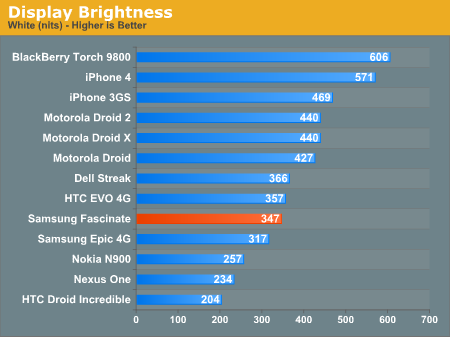

Black levels are perfect again, and thus so is contrast.
I have to agree with Anand - if resolution is what you care about, the iPhone 4 leads. If contrast and seriously vibrant (to the point of being oversaturated) colors are what you like, Super AMOLED is where it's at.


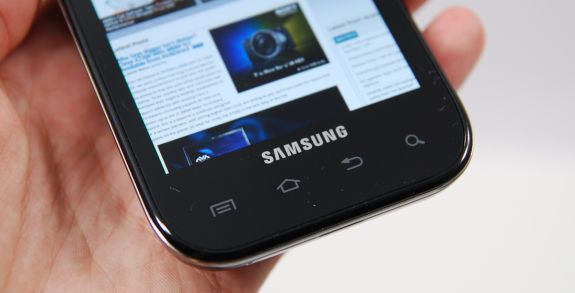
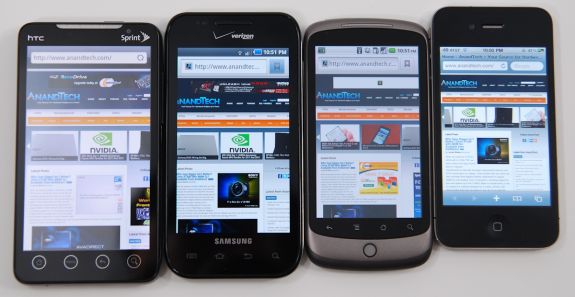
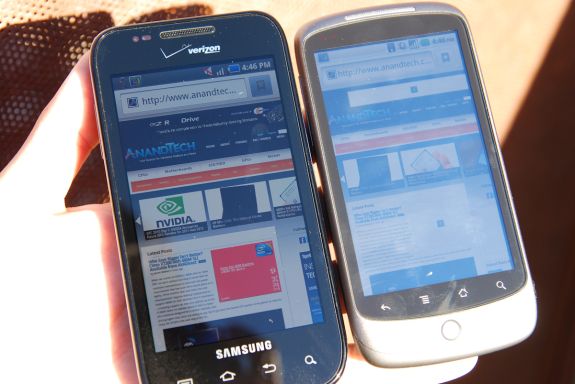














73 Comments
View All Comments
metafor - Tuesday, October 5, 2010 - link
That seems to be a common misconception. Just think about it, the processor is somewhere around ~500mW doing an intensive task. Compare that to an RF radio chip that eats 2W or so while communicating to a 3G cell tower. Or the 2-3W display....The App Processor is a small percentage of overall power draw.
strikeback03 - Tuesday, October 5, 2010 - link
Agreed, checking the power usage utility on Android it isn't uncommon to see the screen drawing the vast majority of the power. Which AMOLED has the potential to help with if there were a way to format websites to be more friendly to it (i.e. no white backgrounds).metafor - Tuesday, October 5, 2010 - link
I'm personally banking on either Pixel Qi or Mirasol improving to the point where they can take over being the displays used. The power savings would warrant any apparent difference in image quality as long as it's "good enough".JimmiG - Wednesday, October 6, 2010 - link
"Just think about it, the processor is somewhere around ~500mW doing an intensive task. Compare that to an RF radio chip that eats 2W or so while communicating to a 3G cell tower. Or the 2-3W display...."I guess you're right. I can play games and watch video on my HTC Desire without using much battery, but 3G browsing absolutely kills battery life. My daily routine involves heavy 3G web browsing on the 1-hour commute to school by train, then the phone spends most of the day in standby, then another hour of heavy usage on the way home in the afternoon. This is enough to run the battery down to ~10% by the time I get home, if I'm lucky enough to have it last the whole day.
But then, how does the iPhone4 manage nearly 7 hours of 3G browsing? Does it use a different radio chip, is it the network, or what?
metafor - Wednesday, October 6, 2010 - link
RF chips don't really vary that much. I would take a guess that it's good software management. What you don't realize is that most of the time you're browsing, you're not actually loading data. You have a burst of data as the website loads, but then it stops.I've noticed on my iPhone that periods of inactivity -- while I'm reading a webpage -- would cause the signal bar to drop a bit. It would go back up once I clicked on a link.
I suspect the software is putting the RF chip in a low-power mode more aggressively than HTC equivalents.
A lot of people discount it but software throttling is the single-most effective way of reducing power consumption.
ssj4Gogeta - Tuesday, October 5, 2010 - link
Is there any chance you'll do an I9000 review? It's the European/Asian version of the Galaxy S. It comes unlocked, doesn't have loads of crap preinstalled, and trades the LED flash for a front VGA cam. It also doesn't have a search button, but you can long-press the menu button to search.Also, please consider trying the voodoo lag fix in your future Galaxy S reviews.
http://project-voodoo.org/
It basically changes the system partition file system from RFS to EXT4, which makes the phone noticeably faster and smoother (no stalling while installing apps, no stuttering..)
8steve8 - Tuesday, October 5, 2010 - link
i personally have an international galaxy s with beta froyo rom (JPK), with lagfix, these are the numbers i get:Rightware BrowserMark:
35345 : my galaxy s 2.2
29018 : fascinate 2.1
sunspider:
07375.8ms : my galaxy s 2.2
15835.0ms : fascinate 2.1
linpack:
14.399 MFLOPS : my galaxy s 2.2
08.157 MFLOPS : fascinate 2.1
NeoCore Benchmark:
55.6FPS : my galaxy s 2.2
55.6FPS : fascinate 2.1
quadrant:
2000ish : my galaxy s 2.2 w/lagfix
0800ish with my galaxy s 2.1 stock
the phone ships with a terrible filesystem setup, causes severe lag over time... as shown in the quadrant score which does some IO stuff... this is fixable with root and a lagfix app...
and gps works about as good as my nexus one
(although in 2.1 builds of the firmware GPS was terrible)
this has been said by everyone, but the 4" SAMOLED displays on these things are sick... makes a nexus one display look really dated, and although props to the iphone for finally getting hi-res, 3.5" just seems comparably too small.
annoying it shipped so broken, but once dealt with, a beautiful device and over-all experience
ssj4Gogeta - Wednesday, October 6, 2010 - link
You don't even require root for voodoo lagfix. It comes in an update.zip and changes the filesystem to ext4.webmastir - Tuesday, October 5, 2010 - link
fantastic review. this is why i love this site! great job & great info.Shadowmaster625 - Tuesday, October 5, 2010 - link
If you can forget that a $500+ piece of hardware is in your pocket, then you need to be... outsourced.